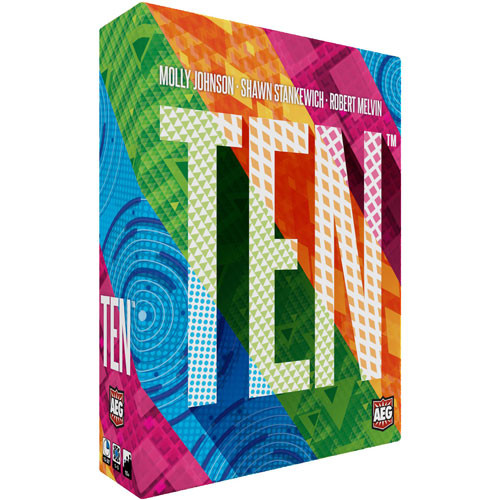Somehow I never reviewed TEN, a great small-box card game from the Flatout Games group (Point Salad/City, Verdant), even though I first played it at least two years ago. We broke it out again on Monday and played a quick two-player game, refreshing my memory enough for a writeup. It’s fun, and so easy to teach and play.
TEN comes with a deck of cards numbered 1 through 9 in each of four colors and currency cards of value 1 through 5, with various wild cards I’ll describe in a moment, and black and white tokens used as currency in the game. The goal is to create sequential runs of cards in each of the four colors. You’ll score one point per card in your longest run for each color, and if you complete a run of cards 1 through 9, you get an extra point as a bonus.
On your turn, you flip cards from the top of the deck until you choose to stop, or until you bust by exceeding ten in total value on the numbered cards or on the currency cards (but not combined). If you chose to stop, you can take all of the numbered cards into your hand and all opponents get the tokens shown on the currency cards, or you can take the number of black tokens shown on the currency cards and your opponents get nothing. In the latter case, you move the numbered cards into the ‘market.’ If you take the numbered cards, you then get to buy one card from the market by paying tokens equal to its face value.
If you bust, then the numbered cards go to the market and you get a white token, which is equal to three black tokens. You can use black and white tokens to buy cards or in the auctions of wild cards (put a pin in that), and you can also discard any cards from your hand for a value of one in any purchase action.
The wild cards come in three flavors. One is just a straight wild card, which can be any color and any number of your choice; you don’t have to decide any of this until the end of the game. Then there are wild cards of a fixed number where the color is wild, and ones where the color is fixed and the number is wild. When the active player flips one over from the deck, they pause their turn and a one-round auction begins; the active player will always get the last bid. Then they resume their turn.
Play continues until the deck is exhausted; you alter the size of the deck based on the player count. Then each player picks the values/colors for their wild cards and scores their longest run of consecutively numbered cards in each of the four colors. That’s all there is to it.
TEN works best with more players, of course, as there’s more competition for the cards and within the auctions. You can’t plan on certain cards still being in the market, or know that once your opponent took a green 3, they’re not likely to keep another one, whereas in a two-player game, you’re probably going to get most of the cards you need, and the auctions are anticlimactic. Two-player still works, as long as you are fine with the higher scores and the probability that you’ll both finish at least two nine-card runs.
You can definitely throw this in a bag without the box – you don’t even really need the tokens if you have a pile of coins, and the cards are just a fat deck you can secure with a rubber band – and the teach is super quick. My younger stepdaughter had no problem grasping the game, and in our most recent play I beat her by just a single point, with only a little help required to get her to see how to maximize the points for the wild cards she had at game-end. The push-your-luck aspect of TEN is so fun and so easy for people to understand that I can’t imagine anyone over the age of 7 who wouldn’t be able to play it. I’m going to start bringing it on more trips.

Hey Keith, this is v random but not sure how else is best to contact you as…the only person I know of in Delaware (and whose opinion I’d trust!). We’re looking for someone who would know about Delaware AG political dynamics, for what I’d consider an important corporate accountability push (see the website linked with this comment). If you know anyone, or know anyone who would know anyone, it would be much appreciated if you could email me at the address provided with the comment. It’s a bit niche and we’re having trouble finding anyone in the know.